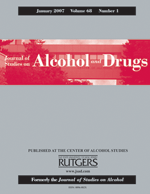This study tested the Theory of Planned Behavior (TPB) as a predictor of growth in risky college drinking over a 3-month period. As predicted by the TPB model, it was hypothesized that attitudes, subjective norms, and perceived behavioral control would predict intention to engage in risky drinking, which would in turn predict growth in future risky drinking.
Participants were 837 college drinkers (64.2% female) who were randomly selected from two U.S. West Coast universities to participate in a larger study on college drinking norms. This study used latent growth analyses to test the ability of the TPB to predict baseline levels of as well as linear and quadratic growth in risky college drinking (i.e., heavy episodic drinking and peak drinking quantity).
Chi-square tests and fit indices indicated close fit for the final structural models. Self-efficacy, attitudes, and subjective norms significantly predicted baseline intention, which in turn predicted future heavy episodic drinking. Self-efficacy and attitudes were also related to intention in the model of peak drinking; however, subjective norms were not a significant predictor of intention in the peak drinking model. Mediation analyses showed that intention to engage in risky drinking mediated the effects of self-efficacy and attitudes on growth in risky drinking.
Findings supported the TPB in predicting risky college drinking. Although the current findings should be replicated before definitive conclusions are drawn, results suggest that feedback on self-efficacy, attitudes, and intentions to engage in risky drinking may be a helpful addition to personalized feedback interventions for this population.
Request Reprint E-Mail: collinss@uw.edu
